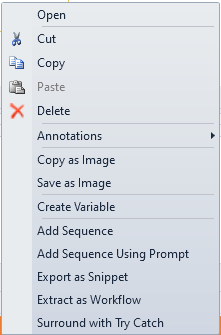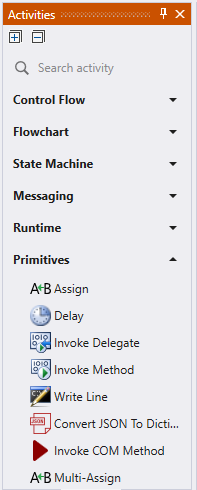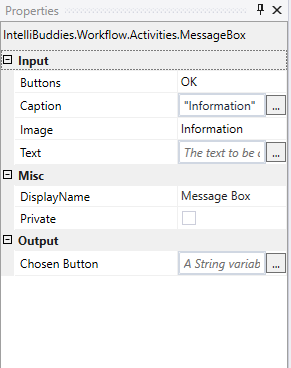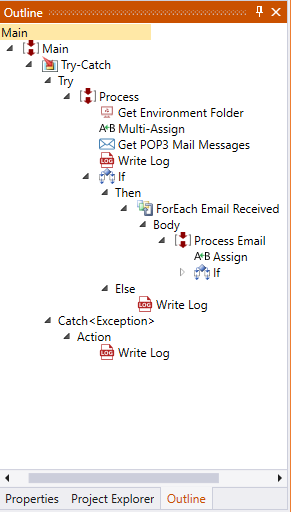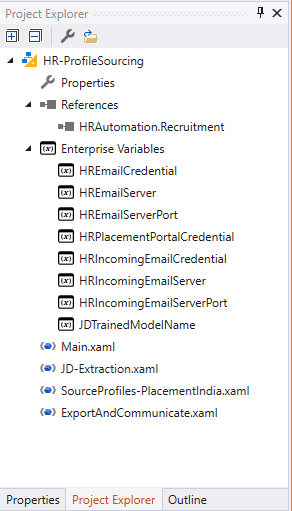UI Panels
Designer Panel
You can view your process or workflow from the Designer panel. It enables you to modify the workflow and also allows you to work with the variables, arguments, and imports required and created for the current Project.
You can navigate within the process diagram inside this panel by double-clicking the activity you want to view. The pathway is presented as breadcrumbs in the header of the Designer panel.
You can copy activity from here using the keyboard shortcut Ctrl + C or from the context menu and paste them again into the Designer panel.
You can activate Pan mode by clicking the icon. You can use the zoom drop-down to change the zoom level.
You can use fit-to-screen to fit the entire workflow within the Designer panel.
You can click on it to get an overview of the Project by navigating the section and adjusting the focus.
Context Menu
The context menu enables you to perform several operations on your process or workflow. You can bring up the context menu by right-clicking any activity in your process or workflow.
| Option | Description |
|---|---|
| Open | Opens the selected activity in the Designer panel. It has the same result as double-click |
| Collapse | This collapses the content of the selected activity and allows it to display only minimal content. You can also achieve the same functionality by clicking on it NOTE: This is available only for Sequence activity |
| Expand in Place | This expands the content of the selected activity and allows it to display more detailed content. You can also achieve the same functionality by clicking on it NOTE: This is available only for Sequence activity |
| Cut | Removes the selected activity and places it onto the Clipboard |
| Copy | Copies the selected activity into Clipboard |
| Paste | Pastes or Inserts the content from the Clipboard to the current location |
| Delete | Deletes the selected activity |
| Add Annotation | Insert an annotation node to the current activity to provide your notes or comments. You can dock or undock the annotation block after adding |
| Edit Annotation | Edit the annotation notes attached to the selected activity |
| Delete Annotation | Delete the annotation attached to the selected activity |
| Show All Annotations | Shows all the annotations added to the activities under the current process or workflow |
| Hide All Annotations | Hides all the annotations added to the activities under the current process or workflow |
| Delete All Annotations | Deletes all the annotations under current process or workflow |
| Copy as Image | Copies the screenshot of the content displayed as part of Designer panel onto Clipboard |
| Save as Image | Copies the screenshot of the content displayed as part of the Designer panel and prompts the dialog for the user to set the details for saving it |
| Create Variable | Creates a variable in Variable panel |
| Export as Snippet | Creates a new snippet containing the selected activity. The arguments to this new snippet are created automatically based on the variables used in the selected activity. The new snippet created will be visible in the Snippets panel. This functionality enables the reuse concept. |
| Extract as Workflow | Creates a new workflow containing the selected activity. It enables the breaking down of large processes or workflows into smaller ones. The arguments for this new workflow are created automatically based on the variables used in the selected activity. You can replace the selected activity with the Invoke Workflow activity, enabling you to edit and import arguments from the newly created workflow. |
| Surround with Try Catch | Embeds the selected activity inside a Try-Catch block |
| Disable Activity | Disables the selected activity by placing it inside a CommentOut activity |
| Enable Activity | Enables the previously disabled activity |
| Add Sequence | Adds the sequence at the selected position. |
| Add Sequence Using Prompt | Adds the sequence at the selected position based on the prompt. The option is available only for the Enterprise edition. |
Activities Panel
The Activities panel displays a comprehensive list of activities to build processes or workflows. The search bar at the panel's top allows you to locate a specific activity by name.
Activities are classified or grouped based on their functionality. You can navigate them using navigation keys, select an activity, and drag and drop them into the Designer panel to build your workflow.
Snippets Panel
The Snippets panel displays all the snippets you created. The purpose of snippets is to enable users to reuse automation easily.
Properties Panel
The Properties panel lets you view and modify a selected activity's properties. It also provides a mechanism to configure the activity by setting its appropriate properties based on the context of your process or workflow.
Expression Editor
The Expression Editor is available from the Properties panel. It can be found in fields or properties that require inputting text or in the body of the activity. You can pop it up by clicking the [...] button at the end of the field or property.
Expression Editor allows you to write expressions in multiple lines. It supports C# and VB language expressions. You can choose the language when creating the Project.
You can utilize Keyboard Shortcuts to create variables from Expression Editor.
| Keyboard Shortcut | Description |
|---|---|
| Ctrl + K | Creates a variable of the input field type as the activity requires. If an expression already exists in the field, you can select the existing expression or text and then hit Ctrl + K to create a variable with the selected expression as name |
Outline Panel
The Outline panel displays the process or workflow hierarchy with all available activity nodes. It also highlights the activities in this panel based on the selection done in the Designer panel. You can also go to a specific activity in the Designer panel by selecting it in the Outline panel.
Output Panel
The Output panel displays the process output from either WriteLog or WriteLine activities. You can use this panel to troubleshoot the process before it is published to Control Room and executed by Buddies.
Error List Panel
The Error List panel displays errors found in the process or workflow during the validation process. Double-clicking on the error will enable the Designer panel to show the corresponding activity for quicker resolution.
Prompt Panel
The Prompt Panel is one of the gateways to access IntelliFlow Services and execute the IntelliFlow Prompts. The prompts executed from here will directly impact the currently active workflow in the Designer Panel.
- Specify the prompt from which you want to create the sequence.
- Click on the Run (Arrow) button in the bottom right corner of the panel.
- It will add the generated sequence at the selected position in the workflow.
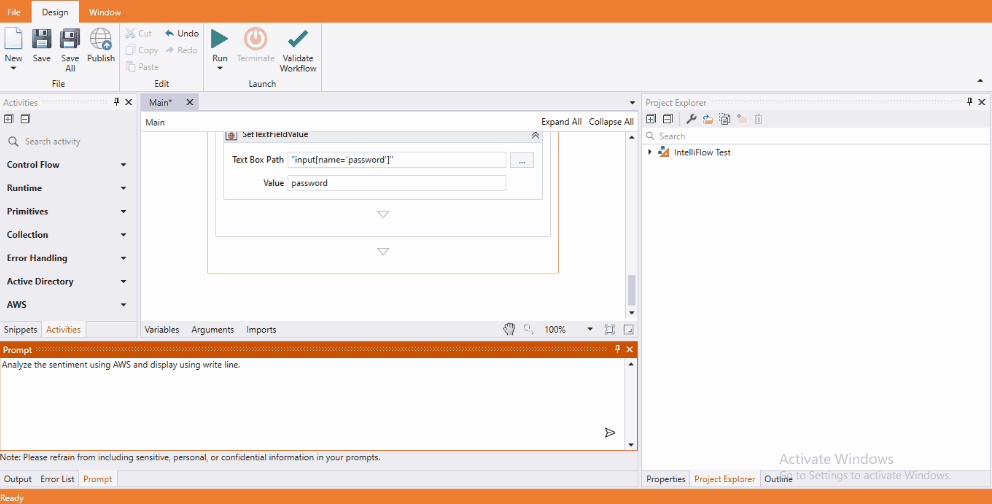
This panel is available only for the Enterprise Edition.
Variables Panel
The Variables panel enables you to create variables and change them.
| Field | Description |
|---|---|
| Name | The name of your variable. A name will be generated automatically by default, but you can override it by editing the autogenerated name. |
| Variable type | Enables you to choose the type of your variable. The drop-down has the following options:
This is a mandatory field. |
| Scope | The scope of this variable. By default, they are available for the entire Project. This is a mandatory field |
| Default | This is an optional field. You can specify a default value for this variable. |
Context Menu
| Option | Description |
|---|---|
| Delete | Delete this variable |
| Add Annotation | Add an annotation to the selected variable |
| Edit Annotation | Edit the annotation added to the selected variable |
| Delete Annotation | Delete an existing annotation to the selected variable |
Arguments Panel
The Arguments panel enables you to create arguments and change them.
The following table describes the properties available for arguments.
| Field | Description |
|---|---|
| Name | The name of your argument. A name will be generated automatically by default, but you can override it by editing the autogenerated name. |
| Direction | Select the direction of your argument. You can select from the following options:
|
| Argument type | Enables you to choose the type of your argument. The drop-down has the following options:
This is a mandatory field. |
| Default | This is an optional field. You can specify a default value for this argument. |
Context Menu
| Option | Description |
|---|---|
| Delete | Delete this argument |
| Add Annotation | Add an annotation to the selected argument |
| Edit Annotation | Edit the annotation added to the selected argument |
| Delete Annotation | Delete an existing annotation to the selected argument |
Imports Panel
From the Imports panel, you can view all the namespaces available in this Project and add a new Namespace to the list.
To add a new namespace, type it in the Enter or Select namespace text box at the top of this panel. This will bring up the namespaces. Select the required namespace and press the Enter key to import it to your Project.
Project Explorer Panel
The Project Explorer panel lists all the workflow XAML files and related resource files used in this Project.
Contents of Project Explorer
The table below describes the contents of the Project Explorer panel and its associated functions.
| Content-Type | Description |
|---|---|
| Properties | You can modify project properties by double-clicking on this content type |
| References | You can add new assembly references to use as part of this Project through right-click context menu options |
| Enterprise Variables | You can add a new Enterprise Variable or an existing one to use as part of this Project from here. Note: |
| Workflow files | You can view the workflow (XAML) files used as part of this Project. You can double-click to open the corresponding workflow in the Designer panel |
| Folders | You can add a new folder or import an existing folder to Project. You can structurally arrange solution items. |
| Resource files | You can view the resources used in this Project. You can double-click to open the corresponding file. |
Project Explorer Settings
In the Project Explorer Panel, you can view the Project folder and options to modify the project settings. There are icons present to perform various operations in Project settings. To know about the operation performed by each button, hover over it to view the tooltip. Here are the details of each button present in the Component settings.
| Settings | icon | Description |
|---|---|---|
| Expand All | Click this button to expand the Project Folder. | |
| Collapse All | Click this button to collapse Project Folder. | |
| Properties | Click this button to open and edit the project properties. | |
| Open Project Folder | Click this button to open the Project folder in Explorer. | |
| Show All Files | Click this button to view all the files in the Project folder, irrespective of whether it is included or not in the project | |
| Add Folder | Click this button to add a new folder inside the Project folder. | |
| Delete | Click this button to remove the selected folder or file from the Project folder. | |
Search for a file inside the Project folder
You can search for files inside the Project folder using the search box.
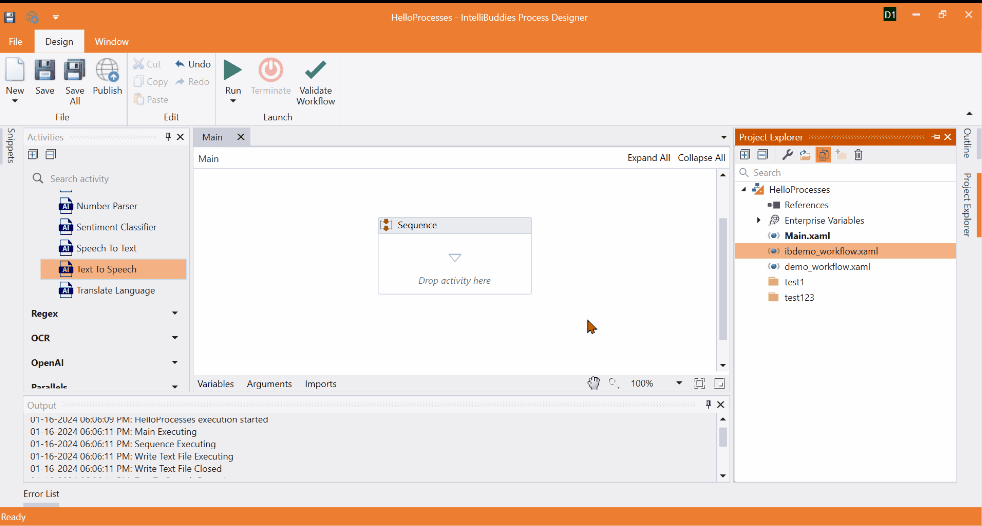
Context Menu options for Project Folder

| Context Menu Options | Description |
|---|---|
| Open Project Folder | Click this button to open the Project folder in Explorer. |
| Add | Click this to see options to add the Workflow Folder to the Project folder |
| Import | Click this to see options to import Workflows, Files, and Folders to the Project folder |
| Properties | Click this button to open and edit the project properties. |
Context Menu options for Project files
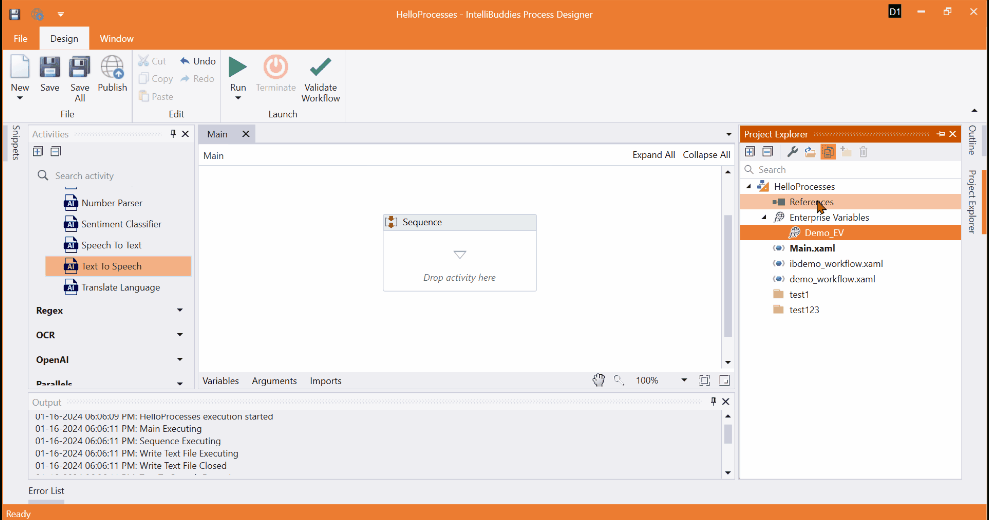
| Context Menu Options | Type | Description |
|---|---|---|
| Add Reference | References | Click this option to add a reference file to the Project. |
| Add Existing | Enterprise Variables | Click this option to add existing Enterprise Variables from the Control Room. |
| Add New | Enterprise Variables | Click this option to add a New Enterprise Variable from the Control Room. |
| Edit | For the variables inside Enterprise Variables | Click this option to edit the Enterprise Variable. |
| Remove | For the variables inside Enterprise Variables | Click this option to remove the Enterprise Variable. |
| Open | *.xaml or other files | Click this option to open the selected file. |
| Set As Main Workflow | xaml files other than Main.xaml | Click this option to set the selected xaml as Main.xaml. |
| Rename | Xaml or other Files, Folders | Click this option to rename existing xaml or other files or folders. |
| Delete | Files, Folders excluding Main.xaml | Click this option to delete the selected file or folder. |
| Include in Project | Xaml or other files, including folders excluding Main.xaml | Click this option to include the selected xaml or other files or folders in Project. |
| Exclude From Project | Xaml or other Files, Folders excluding Main.xaml | Click this option to exclude the selected xaml or other files or folders from Project. |
| Open Project Folder | Folders | Click this option to open the Project folder in Explorer. |
